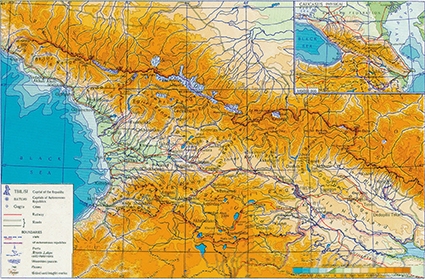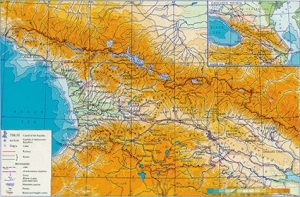Georgia: Geography & Relations with Russia
Looking at Georgia’s position from a larger, regional perspective, one could think that the country is in most part defended by large geographic features. On both the western and eastern sides, you have the Black and Caspian seas (although Georgia does not border the latter), which have served Georgia well, as no foreign invader ever came by sea (well, aside from the legendary Greeks searching for that golden fleece). To the north, there are the Caucasus Mountains, through which it is extremely difficult to enter. Thus, the only natural invasion route into Georgia has been to the south, where the Lesser Caucasus Mountains lie but do not represent an insurmountable geographic feature.
This might suggest that Georgia’s position is actually enviable, but the reality is different. Although no-one thus far has invaded from the Black and Caspian seas, the two have been essentially closed to larger transoceanic trade. This did not create a need on the Georgian side to ever create a trade fleet (the defense of which might have later resulted in the creation of a military fleet) and as such, Georgia has historically remained cut off from European naval developments. The seas and mountains also diminished the ability of the Georgians to gain more territories, as there was simply no land to expand to except for a rugged southern flank.
This context is important for understanding why, throughout the centuries, Georgia developed the way it did, especially so in its relations with Russia and other neighboring countries. Although the majority in Georgia regard Russia negatively, its geographic proximity to Georgia forces the country into economic relations. Georgia’s location allows Tbilisi to be a regional transit hub, and it can’t afford to be oriented towards only one country. This also does not preclude Georgia and Russia from talking to each other and fostering said economic relations. The non-existence of diplomatic relations as well as fundamental differences regarding Abkhazia and Samachablo (South Ossetia) does not stop the Georgian government from creating closer economic contacts with Russian businesses.
It could be argued that Georgia is pursuing a clever strategy of positioning itself not as an anti-Russian state, but also not abandoning its pro-western course. The ideal scenario for Tbilisi is when all the neighboring countries have a stake in the security of Georgia. In addition, large players such as China, with its Belt and Road Initiative, the EU, the US and others are also involved in the economics of the country, creating a certain balance in the region.
This is a strategy that Georgian rulers have pursued throughout centuries: playing one big dominant neighbor against the other. The history of Georgia also teaches that the country might be enemies with a neighboring state, but geopolitics can at times mean Georgia still has to maintain relations. This is especially so nowadays, in an era of increasing interconnectedness where neighboring rival countries cannot ignore economic cooperation. Economic interconnectedness through supply chains eventually breaks down large geographic and Man-made barriers like those, for instance, created between Samachablo and the rest of Georgia.
What is the future of Georgian-Russian relations? How far could cooperation go? These are too big to answer, but it nevertheless shows that Tbilisi and Moscow have much to talk about. Both could cooperate in the security realms as well as deepening economic ties.
However, this potential limited cooperation doesn't guarantee a rosy picture for the future of Russia-Georgia relations. Moscow is very unlikely to give up on its policy towards Samachablo and Abkhazia, while Tbilisi will remain on principle pushing for keeping its territorial integrity. Moreover, Russia has issues with Georgia’s pro-western course, as it endangers Russia’s geopolitical goals in the Caucasus.
These fundamental problems will cap any improvements in relations, which brings to mind the current essentially frozen state of relations between the two countries.
By Emil Avdaliani
Image source: maps-of-the-world.net












